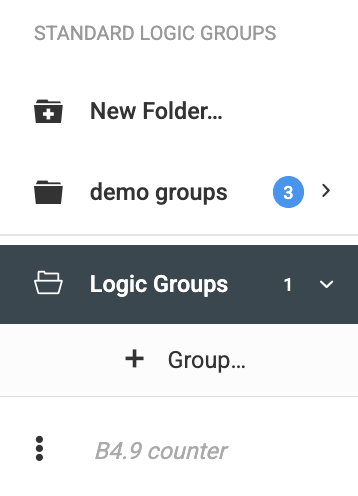Getting Started
Start
LOGIKEDITOR is started via the EIBPORT home page.
User Authentication
You can log in to LOGIKEDITOR using the user data stored in the EIBPORT (cf. Short Manual).
Logic Groups
In order to obtain a canvas allowing for creating the graphic links with inputs and outputs, a new logic group must be created.

Functional Modules
Within logic groups, there are three possible types of functional modules:
Tools (simple operators)
Connection to the system / data points
Connection to the system and other functional areas of EIBPORT is established by configuring the inputs and outputs. Depending on the data point selected, the input and output objects provide the corresponding tie points in so doing. Information on data point linking can be found in chapter Datapoints.

Currently, LOGIKEDITOR supports KNX. Further bus systems will be added in the following expansion stages (e.g. EnOcean, etc.). Information on how to load a KNX project can be found in chapter KNX Projectdata (ETS) import.
Internal Links
In order to link the functional modules (value input, value output, logic elements, tools) to one another, it is sufficient to draw lines between the tie points. See chapter Internal Links for additional information.
Logic Elements & Tools
Along with logic elements, providing a very comprehensive scope of functions, there additionally are so-called "tools", with the help of which simple actions can be implemented within the links between two functional modules. A description of the existing logic elements can be found in the chapter Logikelements, and a description of the tools can be found in chapterTools .
Add Logic Elements:

Add Tools:

Working Copies
LOGIKEDITOR works with "working copies". During configuration, a working copy is automatically opened in the browser, which can then be edited there but does not have any influence on current operations. The settings can be simulated in the working copy. In order to activate the modified configuration for the system, the working copy must be transferred to the device using "Activate". See chapter Logic Groups - The LOGIK EDITOR Canvas.
Simulation Mode
LOGIKEDITOR has a simulation mode that can be used to set any start time and time scaling. See chapter Logic Groups - The LOGIK EDITOR Canvas.
Keyboard Commands
In addition to mouse and touch control, the LOGIKEDITOR also supports keyboard commands. Besides a number of generally available shortcuts, there are some that only work on certain pages. You can get an overview of the supported commands on any page by pressing the '?' key, or clicking on the question mark symbol in the right area of the top bar.
///
